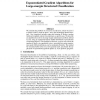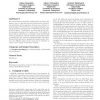GRC
2008
IEEE
14 years 1 months ago
2008
IEEE
Granular computing is gradually changing from a label to a new field of study. The driving forces, the major schools of thought, and the future research directions on granular co...
NIPS
2004
14 years 1 months ago
2004
We consider the problem of structured classification, where the task is to predict a label y from an input x, and y has meaningful internal structure. Our framework includes super...
ECIR
2006
Springer
14 years 1 months ago
2006
Springer
We investigate the use of clustering methods for the task of grouping the text spans in a news article that refer to the same event. We provide evidence that the order in which eve...
IJCAI
2007
14 years 1 months ago
2007
Recently, significant progress has been made on learning structured predictors via coordinated training algorithms such as conditional random fields and maximum margin Markov ne...
ICALT
2003
IEEE
14 years 5 months ago
2003
IEEE
We provide empirical support for the assertions that high level of knowledge construction is associated with structured design and that knowledge construction is associated with c...
IPTPS
2004
Springer
14 years 5 months ago
2004
Springer
Structured peer-to-peer (p2p) overlay networks provide a decentralized, self-organizing substrate for distributed applicad support powerful abstractions such as distributed hash t...
WEBDB
2005
Springer
14 years 6 months ago
2005
Springer
Large-scale information integration, and in particular, search on the World Wide Web, is pushing the limits on the combination of structured data and unstructured data. By its ver...
GECCO
2005
Springer
14 years 6 months ago
2005
Springer
We present discrete stochastic mathematical models for the growth curves of synchronous and asynchronous evolutionary algorithms with populations structured according to a random ...
CW
2005
IEEE
14 years 6 months ago
2005
IEEE
XML information retrieval (XML-IR) systems aim to provide users with highly exhaustive and highly specific results. To interact with XML-IR systems, users must express both their ...
SEMWEB
2007
Springer
14 years 6 months ago
2007
Springer
While the Semantic Web requires a large amount of structured knowledge (triples) to allow machine reasoning, the acquisition of this knowledge still represents an open issue. Indee...




